
 |
|
|||||||
| Hobbies, Crafts, Interests Do you like to knit? Throw pottery? Go fishing? Camping? Have Pets? Make jewelry? Tell us about it here! |
 |
|
|
Thread Tools | Display Modes |
|
|
#21 |
|
Senior Member
How Do You Identify?:
Femme Preferred Pronoun?:
She, please Relationship Status:
Loved Up Join Date: Nov 2009
Location: Western MA
Posts: 2,183
Thanks: 9,001
Thanked 6,553 Times in 1,552 Posts
Rep Power: 21474854            |
Great thread, thank you!
 I love kayaking. I love the truly unique vantage point and experience I have in the water in a kayak: the proximity to birds and fish - the views of land - the quietness & peacefulness of it. I learned in a white water kayak and it is still my favorite "medium", but I don't get to do it very often these days. I've been moving around quite a lot over the course of the last ten years, so I don't have any of my own equipment right now. I rent equipment and go whenever I can, where ever I am. I often get out on fresh water and slow rivers in my local area; I get out in a sea kayak a couple times a year off the coast of Cape Cod and very occasionally I get the opportunity to kayak in white water. In November I went out in sea kayaks off the Island of Hawai'i, that was truly amazing - I was kayaking with huge sea turtles and dolphins.
__________________
I am made of stars |
|
|

|
|
|
#22 |
|
Senior Member
How Do You Identify?:
With my drivers Lic. Preferred Pronoun?:
Gentleman.. Depends on the Situation. Relationship Status:
Last Rodeo, what a ride, many sunrises & sunsets to be had... Join Date: Nov 2009
Location: where a realtor had me sign the dotted line
Posts: 1,901
Thanks: 6,466
Thanked 5,456 Times in 1,450 Posts
Rep Power: 21474854            |
Oh the Envy... You scored Afixer on the canoe! Hope you get to finish fixing it up and posting pictures! Thank you for sharing. And I love that you could show what model kayak you have! Mine is old, and you really can't find pics online anymore, lol. Guess I will have to take pics of mine later. The original Aquaterra Prism trademark was taken over by Perseption kayaks, so needless to say they stopped making this model. Out dated like me
 Sparkle, I love how you descibe the view of seeing it at birds view. Being able to see things that you don't get to see being on land. For me, I have never really river yaked, I do have an adventurous mind to try white water. But have only been a wave rider and angler yaker. Wow, now I really want to try river/white water challenge, sounds exciting. |
|
|

|
|
|
#23 |
|
Senior Member
How Do You Identify?:
Femme Preferred Pronoun?:
She, please Relationship Status:
Loved Up Join Date: Nov 2009
Location: Western MA
Posts: 2,183
Thanks: 9,001
Thanked 6,553 Times in 1,552 Posts
Rep Power: 21474854            |
The perspective is great and its different from other types of boating experiences; when I am in a kayak I really feel I am experiencing the water (like when I swim or snorkel). In canoes/boats/motorized boats - I feel like I am on top of the water, but in a kayak I feel I am IN it.
White Water kayaking is very exciting and challenging. It is also the most expensive way to kayak; the boat and paddles are more expensive and they get banged up much more quickly, and if you are renting equipment you need a helmet and a wet suit and certification/proof of experience at different rapids levels. But the boats themselves are very cool, so small and agile. Turasultana, I've always wanted to kayak the Hudson around Manhattan but the boat traffic (BIG boat traffic, specifically, has always intimidated me).
__________________
I am made of stars |
|
|

|
|
|
#24 |
|
Senior Member
How Do You Identify?:
With my drivers Lic. Preferred Pronoun?:
Gentleman.. Depends on the Situation. Relationship Status:
Last Rodeo, what a ride, many sunrises & sunsets to be had... Join Date: Nov 2009
Location: where a realtor had me sign the dotted line
Posts: 1,901
Thanks: 6,466
Thanked 5,456 Times in 1,450 Posts
Rep Power: 21474854            |
 Yesssssss I found pics online of my model  My yak is like the white one on the picture above, but I rigged it for fishing. Putting a Scotty rod holder, rod pipes behind the seat, and making a PVC rocket launcher to hold 5 poles or a net and 4 poles, lol. The only dislike of this model is the hatches leak if flipped making it an awful time trying to right it back. So I try hard not to turtle. |
|
|

|
| The Following 3 Users Say Thank You to Blaze For This Useful Post: |
|
|
#25 | |
|
Member
How Do You Identify?:
human Preferred Pronoun?:
ma'am Relationship Status:
adrift in my head Join Date: Jan 2010
Location: in and out of the woods
Posts: 989
Thanks: 491
Thanked 1,507 Times in 659 Posts
Rep Power: 8660555            |
Quote:
and this places rents. Hudson Valley Outfitter's I may have to try them out next spring. 
|
|
|
|

|
| The Following User Says Thank You to afixer For This Useful Post: |
|
|
#26 |
|
Senior Member
How Do You Identify?:
With my drivers Lic. Preferred Pronoun?:
Gentleman.. Depends on the Situation. Relationship Status:
Last Rodeo, what a ride, many sunrises & sunsets to be had... Join Date: Nov 2009
Location: where a realtor had me sign the dotted line
Posts: 1,901
Thanks: 6,466
Thanked 5,456 Times in 1,450 Posts
Rep Power: 21474854            |
Information on River Safety:
RIVER SAFETY Top 10 River Safety Tips 1. Tell someone where you are going, when you expect to return, and where to call if you don't. 2. Make sure that your water skills and experience are equal to the river and the conditions. 3. Never boat alone. Always have at least one (preferrably two) other boats with you on a river trip. 4. Wear a Coast Guard approved type III-V, properly adjusted lifejacket at all times when you are in or near the river. 5. Know your limits of swimmers rescue and self rescue on rivers. 6. Know when and how to swim for the eddy. 7. Reduce injuries by wearing protective foot wear and proper clothing designed for river recreation. 8. Be prepared for extremes in weather, especially cold. 9. Know about hypothermia and how it can affect you. 10. Plan your trip and stick to your plan. International Scale of River Difficulty Flat Water A - Pools, lakes, or rivers with velocity under 2 MPH. B - Rivers with velocity 2-4 MPH. C - Rivers with velocity over 4 MPH. May have sharp bends or obstructions. Whitewater CLASS I - Moving water a few riffles and small waves. Few or no obstructions. CLASS II - Easy rapids with waves up to three feet, and wide, clear channels that are obvious without scouting. Some maneuvering is required. CLASS III - Rapids with high, irregular waves often capable of swamping an open canoe. Narrow passages that often require complex maneuvering. May require scouting from shore. CLASS IV - Long, difficult rapids, with constricted passages that often require precise maneuvering in very turbulent waters. Scouting from shore is often necessary, and conditions make rescue difficult. Generally not possible for open canoes. Boaters in covered canoes and kayaks should be able to Eskimo roll. CLASS V - Extremely difficult, long and very violent rapids with highly congested routes that nearly always must be scouted from shore. Rescue conditions are difficult and there is significant hazard to life in event of a mishap. Ability to Eskimo roll is essential for kayaks and canoes. CLASS VI - Difficulties of Class V carried to the extreme of navigability. Nearly impossible and very dangerous. For teams of experts only, after close study and with all precautions taken. Essential Canoeing/Kayaking Equipment and Gear Endlines - Installed on the bow and stern, a line size of 3/8" diameter and 15' long is optimal. Endlines should be stowed to prevent entanglement but be immediately accessible in the event of a mishap. 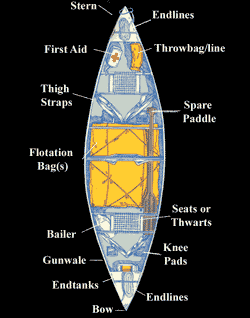 Endtanks/Endbag - Many canoes/kayaks come with built-in flotation in the bow and stern. The flotation should contour the end of the boat whether it is foam block or an inflatable bag. Water Bottle - Be sure to drink plenty of nonalcoholic fluids. Dehydration results from excessive water loss. Take at least one quart of water per person per day. Bailer - Scoop or sponge used to remove lose water from the craft. Spare Paddle - always carry a spare paddle in case yours is lost or breaks. It may be fastened to the canoe but should be quickly accessible in case of an emergency. Flotation Bags - To work best the bags should fit the hull snugly with little or no air spaces. Tie the bags securely in the craft to prevent them from popping out. Thigh Straps - Usually made out of two inch nylon webbing, thigh straps give the paddler more control when maneuvering the craft. Optional class II, recommended class III and above. Seats or Thwarts - Kneeling provides a lower center of gravity and stability through the triangulation of the legs in the bottom of the craft. The lower the height of the seat the more stability can be achieved. Ten to twelve inches above the bottom of the craft is good. Throwline/Throwbag - Sixty to seventy feet of soft braided 3/8" polypropylene line to be used for rescue purposes. Knee Pads - Usually made out of soft foam rubber, knee pads should protect the knees while kneeling. Also, they should affix the knees firmly to the hull. This increases the paddler's ability to maneuver the craft. Choosing River Clothing Cold Water Like standing in a cold shower, cold water can drive the breath from a person upon impact with the water. It disorientates, totally robs a person's strength, quickly numbs the arms and legs, and within minutes the resulting severe pain can cloud rational thought. Finally, hypothermia (exposure) sets in, and without rescue and proper first aid treatment, unconsciousness and death may result. Experts consider water below 70 degrees F to be cold. Some experts use the "100 Degree Rule". If the air and water temperature combined to less than 100 degrees a wet or dry suit is mandatory and the river difficulty is considered one class more difficult than normal (i.e. Class II becomes Class III). To protect against the effects of cold water, the paddler should select and layer clothing properly. One should know how to spot a hypothermic accident before it happens. Always plan a trip appropriately. Lastly, good paddling skills and equipment can often help the paddler avoid a situation which may lead to hypothermia. Cold Weather Clothing Helmet - Wear a good plastic or fiberglass helmet. Make sure that it protects your temples. A helmet is recommended for open canoeists on any river Class III or above. Whistle - A must for communications. The sound of a whistle carries over the roar of the river and much further than that of the human voice. Pouch - For storing valuables including car keys for the shuttle car and money for an emergency phone call. Lifejacket - The lifejacket (PFD) should fit snugly, yet allow freedom of movement. A vest type jacket (type III) is more comfortable to wear, offers better protection to the lower back, and insulates better in cold weather than the inexpensive horse collar jacket (type II). Dry/Wetsuit - Made of rubberized material the drysuit seals the paddler in a water tight shell. Normal paddling clothes can be worn underneath it. Made of neoprene the wetsuit traps and insulates a thin layer of warm water next to the body. Both suits should protect the high heat loss areas of the arm pits, crouch, and neck. Sweater - Worn underneath the drysuit. Wool is good. Polypropylene is better. Avoid cotton. It's ability to "wick" moisture will actually make you colder. Layer your clothes so you can put on or take off layers if you get too hot or cold. Knife - (optional) A knife may be carried to free the paddler in case of entrapment. Safety Rope/ Throw Bag - Many experts carry a nylon sling with a carabiner or a mini-throwbag which can quickly be used to rescue another boater. Booties - Wet suit booties with rubber soles are an ideal choice for cold weather. Also, wet suit socks worn inside rubber-soled sneakers or plastic sandals provide good protection. Pogies - Usually fastened directly to the paddle, pogies or mittens protect the hands and wrists from chilling wind. Paddle - Select a sturdy paddle, one made of fiberglass and aluminum. Wood paddles should be constructed with fiberglass reinforced laminated wood. A "T" grip gives better paddle control in whitewater. Warm Weather Clothing Hat/Helmet - A hat protects from the sun. Wear a helmet in Class II and above rivers. Sunglasses - Choose a good pair of neutral density glasses, with straps if necessary. Shirt - Wearing a shirt reduces the likelihood of sunburn. A cotton shirt "wicks" the water which helps the evaporation process cool the body. Lifejacket - For the summer choose an open mesh design lifejacket for its ability to breath. Choose a vest type or jacket (Type III) for its comfort. Swimsuit pants - Light weight pants over the swimsuit are a good idea even in summer. The sun reflecting off the water and the bottom of the boat can quickly bake the legs. Pouch - For storing valuables including car keys for the shuttle car and money for an emergency phone call. Layering Your Clothing Layered clothes insulate better in cool weather than a single garment of the same thickness. Two medium weight sweaters offer more protection than one heavy sweater. Cover the sweaters with a paddling jacket for even more warmth. To trap in additional heat and keep water out, the paddling jacket should fit tightly around the wrists, neck and waist. Layers can be mixed to maximize the strengths of each layer. Some canoeist use a farmer john type wetsuit (no sleeves and legs) for their first layer coupled with a sweater and a paddling jacket on the next layer. This allows the paddler freedom of movement with the wetsuit providing extra protection if a paddler is immersed in the water. Also with layered clothes the paddler can easily adjust his comfort and heat loss by either putting on another layer or taking one off. |
|
|

|
|
|
#27 |
|
Senior Member
How Do You Identify?:
With my drivers Lic. Preferred Pronoun?:
Gentleman.. Depends on the Situation. Relationship Status:
Last Rodeo, what a ride, many sunrises & sunsets to be had... Join Date: Nov 2009
Location: where a realtor had me sign the dotted line
Posts: 1,901
Thanks: 6,466
Thanked 5,456 Times in 1,450 Posts
Rep Power: 21474854            |
How You Loose Body Heat
The water environment of the paddler greatly increases the potential the potential for heat losses through evaporation and convection. Layering your clothes combines the best properties of each garment to reduce heat loss. A sweater reduces convectional losses by creating dead air spaces in the fabric. A paddling jacket reduces air flow and reflects radiated heat losses from the body back toward the body. The summer paddler also needs to protect himself by wearing a hat to reflect the sun's radiation. Also, a cotton shirt and shorts help cool the body by evaporation. Conduction (e.g. hand on aluminum shaft of paddle) Convection (e.g. wind) Radiation (e.g. unprotected head) Evaporation (e.g. wet lifejacket and wet clothing) Common River Hazards Foot entrapment - Catching a foot in rocks on the bottom of the river. May be caused by trying to stand up while getting swept downstream in water mid-thigh to mid-torso deep. Strainers - Trees or single branches in the current, with river water flowing through, can cause a severe pinning hazard. Strainers many be caused by erosion. Trees can also fall because of old age, floods, and storms. Look for them on wooded riverbanks, along small creeks after high water, often found on the outside of bend, and on less utilized rivers. Always look downstream to spot bobbing twigs or irregular flow patterns. Man Made Entrapments - Manmade objects in the river are inherently more dangerous than most things natural. Keep an eye out for bridge pilings, low head dams, junked cars, any man made object found commonly in urban riverways, highway crossings, and abandonned dam sites. Make it a habit to visually scan downstream. Broaches - Getting pinned on a rock, either amidship or at the ends. Avoid sharp rocks that can potentially crease a boat or serve as point to be wrapped by your kayak! Develop the instinct to lean into the rock with your boat and body leaning together. Undercut Rocks - Undercuts are water features where a slab of rock, or rock shape, forces the current flow to go under the surface. Learn to spot them by the dark shadow on the upstream side of the rock, the lack of pillowing action by oncoming water, and by the lack of a predictable eddy on the downstream side. Most dangerous undercuts are well known by locals, and listed in guidebooks. Entanglement - Getting tangled exiting your boat is most likely to be caused by ropes, and loose lines, in your boat. Practice wet exits and critically evaluate your outfitting for entanglement potential. Treat throw ropes as potential hazards. Keep them neatly bagged, and carry a knife for rescue. Vertical Pins - When the bow buries and gets pinned on the bottom after a steep drop. This is not a concern until you are paddling drops of over 3 or 4 feet. Advanced paddlers prevent them by checking the water depth first, and leaning back and performing a 'boof' move to keep the bow up. Paddling boats with a large volume bow reduces this risk substantially. Hydraulics - have evenly formed backwash, water moving back upstream for four or more feet. Holes with more of a wave shape are intimidating, but typically less hazardous than water flowing smoothly upstream. Dams, and hydraulics that are very regular, and perpendicular to the current are far more dangerous than hydraulics angled with one end downstream. Long Swims - Wearing a tight PFD, matching your ability to an appropriate river, and being dressed for a swim can be excellent defense against a long swim. Another great precaution is a competent group of friends with either a shore or boat based rescue plan. Recognizing and Avoiding Hazardous River Conditions Conditions on rivers can change rapidly in Texas. Before setting out, a paddler should know the flow condition of the reach they are about to paddle. During high flows, the whole river reach may act like one long set of rapids. During high flows, the fast current may draw the unsuspecting paddler into other hazards. These include entrapment in floating debris such as logs, sweepers and strainers. A sweeper is an overhanging branch or tree whose branches extend into moving water from above. Running into a sweeper will push a canoe over or could push and hold the paddler below the surface of the water. A strainer is a submerged tree or branches under the surface of moving water. A paddler could become pinned against a strainer. Submerged hazards, such as rocks, logs and other debris, are not easily seen in turbulent water. A collision can cause the boat to upset; the hull may be punctured, or the paddler may be injured in the collision. Once out of the canoe, the canoeist may be overcome by the current or pinned by the canoe. A swamped canoe can weigh as much as two tons and a paddler can be crushed between a canoe and a rock. Cold water (less that 15° C) can be lethal. During spring conditions or in late fall, the river water is cold, and if you spill you can very quickly be overcome with hypothermia. Even if the paddler reaches shore, wind chill and cold air temperatures can accelerate the dangerous drop in body temperature. Shivering is an indication of the onset of hypothermia, and victims usually become too disoriented to be responsible for their own safety. A riverbank is often well removed from emergency services and homes where help can be obtained. The tough reality is that you may be on your own to deal with a life-threatening situation. The tough reality too is that a paddler in danger may also be putting a rescuer's life in jeopardy. Whenever you are on the river, it is important that you are prepared to deal with an emergency. Know where access points are along the reach of river that you are canoeing. Have a map of the reach that you are canoeing. Have a first aid kit and know basic first aid. Finally, a cellular phone in a waterproof bag may be invaluable in contacting help or emergency services. Low head dams pose a special hazard to paddlers. In the fast waters, an upstream paddler may get too close to the crest of the dam and be swept over. A paddler may also get caught in the backwash current at the downstream side of the dam. Once in the backwash current, the paddler becomes trapped. Paddlers should use portages around these structures, and stay well clear of low head dams at any time of the year. Boating safety awareness is not limited to the cold-water seasons. There are good solid rules that must be observed by prudent and safety conscious paddlers everywhere. Boating courses are an enjoyable way to prepare for any kind of boating. Like the Boy Scouts advocate-be prepared. Being prepared before your trip can help avoid potential hazards or result in a positive outcome if an accident does occur. One of the most important considerations is a trip or float plan. Let someone know where you are canoeing, what your boat looks like and when you expect to return. |
|
|

|
| The Following User Says Thank You to Blaze For This Useful Post: |
|
|
#28 |
|
Senior Member
How Do You Identify?:
With my drivers Lic. Preferred Pronoun?:
Gentleman.. Depends on the Situation. Relationship Status:
Last Rodeo, what a ride, many sunrises & sunsets to be had... Join Date: Nov 2009
Location: where a realtor had me sign the dotted line
Posts: 1,901
Thanks: 6,466
Thanked 5,456 Times in 1,450 Posts
Rep Power: 21474854            |
Spotting a Potential Accident
River accidents don't just happen. They usually result from the interaction of a series of smaller events or misjudgements which culminate into a major accident. Experts analyze accidents in terms of their human, equipment and environmental factors. Usually, any one factor will not lead to an accident. However, the presence of three or even four factors in a paddling situation is a sign of serious trouble. In a sense, three strikes and a paddler may be out. The major factors that can lead to river accidents are: 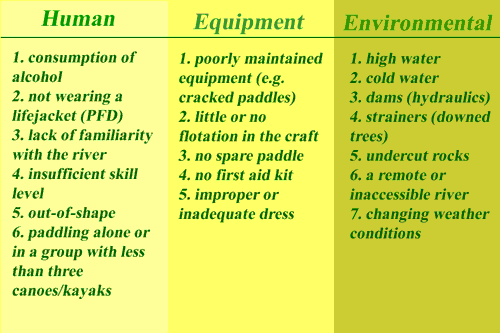 Planning a River Trip Specific planning must be taken seriously by paddlers in preparation for a float trip. The suggested guidelines that follow should give the paddler an insight into what is to be considered before attempting a cruise on a river. Leaders preparedness and responsibility 1. Know the river or stream to be paddled. River guide booklets and topography maps are valuable references in trip planning. Have knowledge of the difficult parts of the trip and the location of any low head dams. Be aware of any possible changes in the river's level. One may want to plan alternatives in case the river/stream is too high or too low. 2. Setup locations for put-in and take-out along with a possible lunch break stop. Consider time and distance. Arrange for shuttle. 3. Participants. Limit the size of the group to a number that can be comfortably controlled. Designated group leaders should be experienced paddlers. Decisions on the participation of inexperienced boaters should be based on total group strength. Remember the welfare of the group is a major responsibility, and a balance of experienced paddlers with the less experienced will make for a more enjoyable trip. 4. Equipment. Plan so that all necessary group equipment is present on the trip. 5. Float Plan. If the trip is into a wilderness area, or for an extended period, plans should be filed with appropriate authorities or left with someone who will contact them after a certain time. The establishment of a late return phone number can save time and worry for everyone involved. Participants Preparedness and Responsibility 1. Be a competent swimmer with the ability to handle ones self underwater and in moving water. 2. Be certain that you have a properly fitted Personal Flotation Device (PFD), and wear it . 3. Be suitably equipped. 4. Keep your craft under control. Control must be good enough to, at any time, stop or reach the shore before reaching any danger. Know one's boating ability. Do not enter a rapid unless one is reasonably sure that it can be navigated safely or that one can swim the entire length of the rapid in the event of a capsizing. 5. Be sure to keep an appropriate distance between canoes (distance will vary depending on water conditions; a good rule of thumb is to always keep the canoe behind in view). Never get ahead of the assigned lead canoe or behind the assigned sweep canoe. Both lead and sweep positions should be held by experienced paddlers with knowledge of the water being traveled. 6. Keep a lookout for river hazards and avoid them. 7. Respect the rights of fisherman and land owners while on your river trip. |
|
|

|
| The Following 3 Users Say Thank You to Blaze For This Useful Post: |
|
|
#29 |
|
Senior Member
How Do You Identify?:
With my drivers Lic. Preferred Pronoun?:
Gentleman.. Depends on the Situation. Relationship Status:
Last Rodeo, what a ride, many sunrises & sunsets to be had... Join Date: Nov 2009
Location: where a realtor had me sign the dotted line
Posts: 1,901
Thanks: 6,466
Thanked 5,456 Times in 1,450 Posts
Rep Power: 21474854            |
|
|
|

|
| The Following 5 Users Say Thank You to Blaze For This Useful Post: |
|
|
#30 |
|
Senior Member
How Do You Identify?:
With my drivers Lic. Preferred Pronoun?:
Gentleman.. Depends on the Situation. Relationship Status:
Last Rodeo, what a ride, many sunrises & sunsets to be had... Join Date: Nov 2009
Location: where a realtor had me sign the dotted line
Posts: 1,901
Thanks: 6,466
Thanked 5,456 Times in 1,450 Posts
Rep Power: 21474854            |
Must-Have Kayak Accessories
 By: Maeve Rich There are kayak accessories available for a wide range of purposes, from storage accessories to kayak fishing accessories. When choosing kayak accessories, take into consideration the weather, the area where you'll be kayaking and your wants and needs. A helmet is one of those kayak accessories that is really more of a requirement, depending on where you'll be kayaking. Any conditions near whitewater necessitate protecting your head. A quick flip of the kayak could cause you to hit your head on a rock or on your kayak and be knocked unconscious: not a good thing when you're in water. Similarly, make sure you have a life vest and I attach a whistle to my vest in case of an accident. This should be worn no matter what type of water you're kayaking in. A spray skirt will keep water out of your kayak. This is great in the ocean as well as whitewater, or anywhere that water gets a bit turbulent. Should water get into your kayak you'll want to have a bilge pump onboard to empty your boat. Float bags will keep your kayak from sinking should you become separated from it. Float bags are stuffed into open storage spaces of your kayak and keep it from filling with water. Dry bags will keep your gear dry, and should be attached to the inside of your boat. You may want to purchase a wetsuit if the water you'll be kayaking in is cold. A wetsuit keeps your body warm by allowing a small amount of water in, which your body heats. Dress as though you will going underwater; that way if you do, you'll be prepared. You should also have equipment on hand in case of an emergency. This may include a compass, GPS, rope bag, knife, radio to call for help and first aid kit. With all of the kayak accessories out there, weigh your options carefully before purchasing. This is especially true if you're new to the sport and aren't sure what you'll need. |
|
|

|
| The Following User Says Thank You to Blaze For This Useful Post: |
|
|
#31 |
|
Member
How Do You Identify?:
human Preferred Pronoun?:
ma'am Relationship Status:
adrift in my head Join Date: Jan 2010
Location: in and out of the woods
Posts: 989
Thanks: 491
Thanked 1,507 Times in 659 Posts
Rep Power: 8660555            |
from my home town
my dream (whitewater) boat and finally a boat for the fishing folks |
|
|

|
|
|
#32 | |
|
Member
How Do You Identify?:
Queer Femme Preferred Pronoun?:
she Relationship Status:
spoken for Join Date: Nov 2009
Location: brooklyn
Posts: 432
Thanks: 226
Thanked 713 Times in 249 Posts
Rep Power: 2043786            |
Quote:
Just be careful crossing the river or a taxi stop, the boats can be on top of you quicker than you expect. Its fun really. 
|
|
|
|

|
|
|
#33 |
|
Senior Member
How Do You Identify?:
With my drivers Lic. Preferred Pronoun?:
Gentleman.. Depends on the Situation. Relationship Status:
Last Rodeo, what a ride, many sunrises & sunsets to be had... Join Date: Nov 2009
Location: where a realtor had me sign the dotted line
Posts: 1,901
Thanks: 6,466
Thanked 5,456 Times in 1,450 Posts
Rep Power: 21474854            |
This link show's you how to fix a hole in your yak, plastic welding.
There are plenty of write ups on the topic, however a video reference is always good. So, if you ever have a need for a DIY repair, the video will hopefully help. http://www.teamoceankayak.com/videos/weld/index.html Tools needed: Repair/patch plastic (Old pickle buckets make good material) Dremel Sauteing Iron |
|
|

|
| The Following User Says Thank You to Blaze For This Useful Post: |
|
|
#34 |
|
Senior Member
How Do You Identify?:
With my drivers Lic. Preferred Pronoun?:
Gentleman.. Depends on the Situation. Relationship Status:
Last Rodeo, what a ride, many sunrises & sunsets to be had... Join Date: Nov 2009
Location: where a realtor had me sign the dotted line
Posts: 1,901
Thanks: 6,466
Thanked 5,456 Times in 1,450 Posts
Rep Power: 21474854            |
How to make a milk crate cart
Here's is a simple kayak cart I made by incorporating the milkcrate as the frame of the cart. When not used as a cart, the milkcrate can be used as a milkcrate (?) in the tank well. The frame post turns into four rod holders. The only items you need to stow when you reached your destination is break down the PVC T-cap, the wheels,shaft, two washers, pin and tennis balls. Here is the material cost: one - Milk Crate ?? one - 1 1/2 inch x 10 feet PVC pipe $4.29 four -90 degree elbow $0.56 each four -T-connector $1.29 each one - 1/2 inch aluminum bar $3.98 two - washer $0.09 two - Cotter pin $0.56 two - 13 1/2 inch plastic wheel $4.00 (or 12 inch with bearing $9.95 each) one - Strap ?? Total $24.97 (Aug 2007) The wheels are from Northern Tools, everything else are from HomeDepot. The plus of the design is that it's a very simple design. It's also simple to build. The 13.5 inch wheel is bigger than anything I've seen out there. You can also cut the shaft longer and put 4 wheels instead of two to give you more stability and to give you the ability to go over soft sand. The minus of the design is that you do need some tools to cut the PCV pipe, 1/2 drill bit and drill to put holes in the pcv pipe, the side of the crate and the tennis ball, 1/16 inch drill bit for the cotter pin hole in the shaft. You also need pcv cement. Because the wheels a only about 15 inch apart, it's not as stable as store bought cart but as long as you keep that limitation in mind when you carting the kayak around, you should be ok. It does well in deep grass. I can go over the curb with a good pull. I have not tested it in deep sand. NOTE: The wheels on the pictures are the 12 inch wheels. I had since purchased the 13.5 inch wheels. The 12 inch wheels are $9.95 each. The tires are inflatable and there are ball bearings on the shafts. The $4.00 plastic wheels are hard plastic like lawn mower wheels with no bearings. Videos: [nomedia="http://www.youtube.com/watch?v=IGSXOoHBpIk"]YouTube - Homemade Milkcrate Kayak Cart (Assembly)[/nomedia] [nomedia="http://www.youtube.com/watch?v=rNxq3fQAr0M"]YouTube - Milkcrate Kayak Cart Disassembly[/nomedia] [nomedia="http://www.youtube.com/watch?v=cVzBcGcq-3o"]YouTube - Milkcrate Kayak Cart - Over the curb test[/nomedia] Pictures: 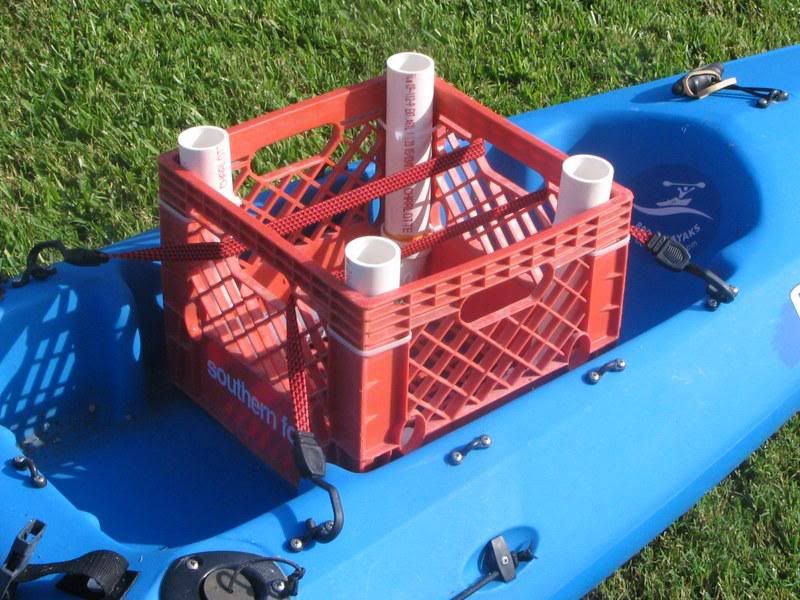  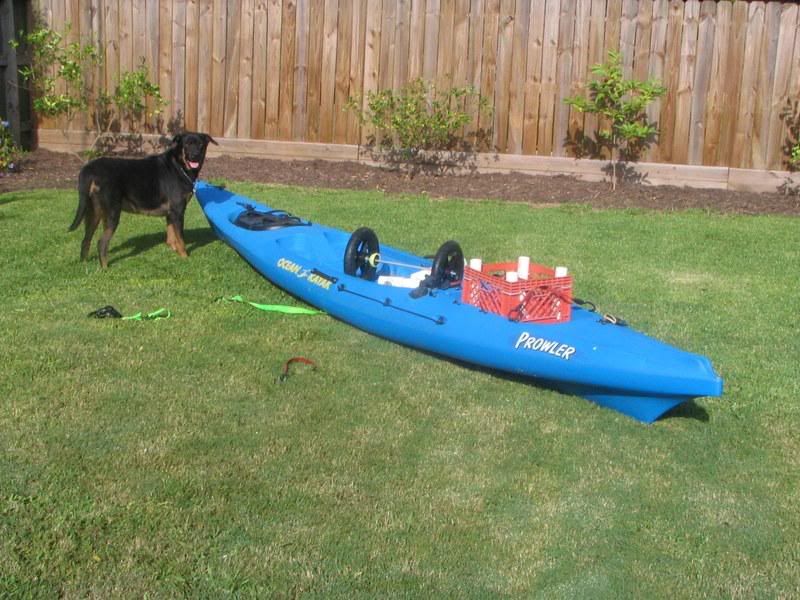 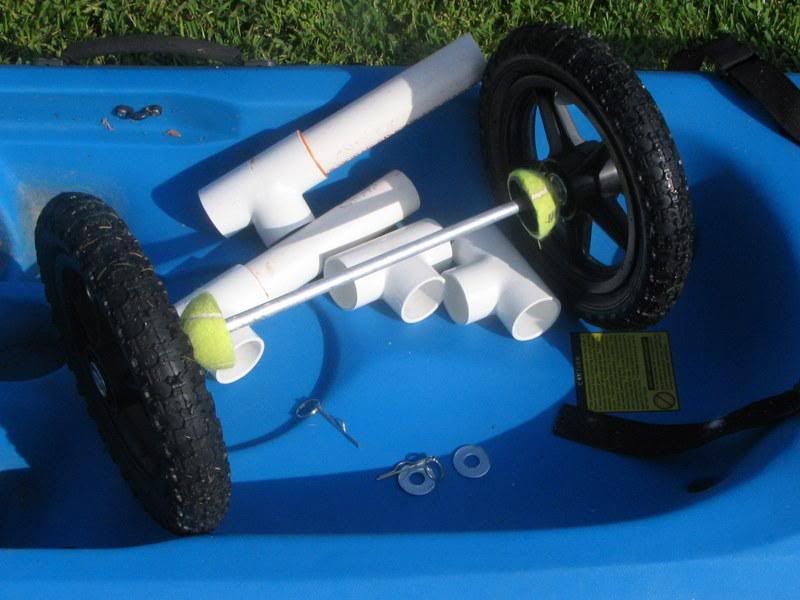 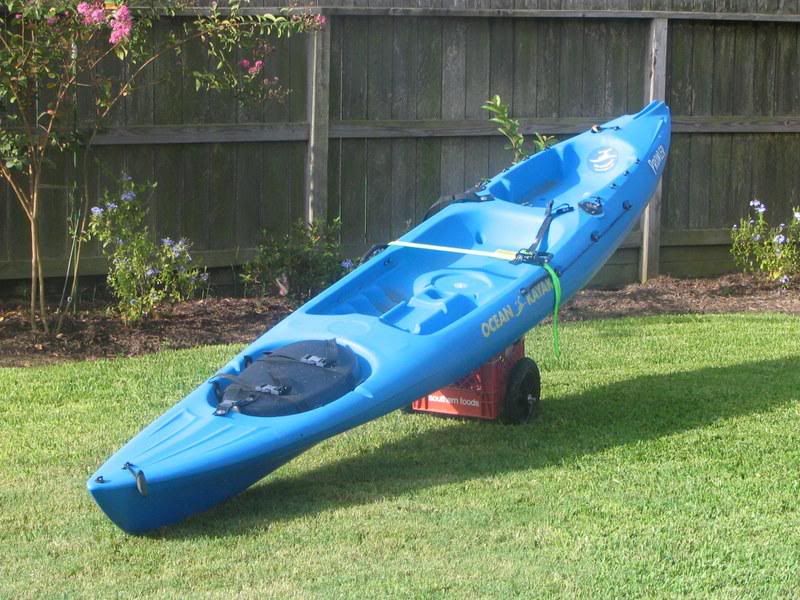 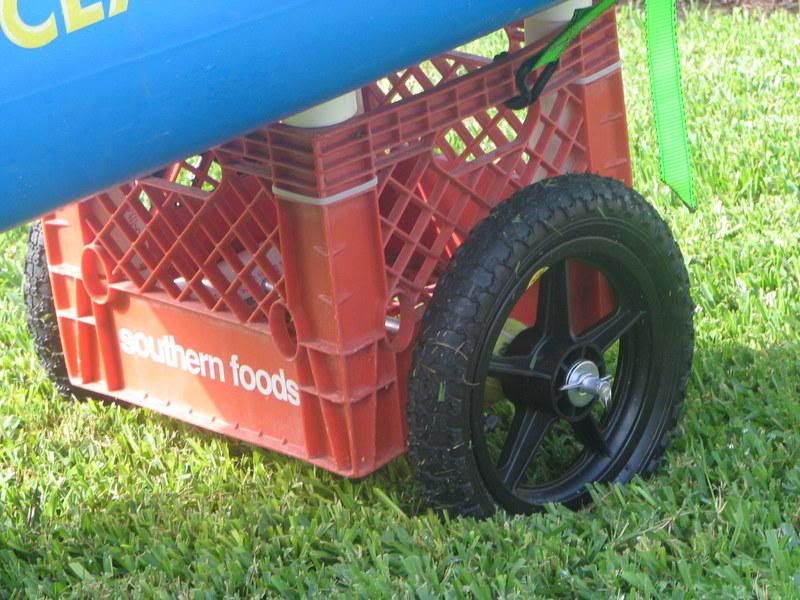 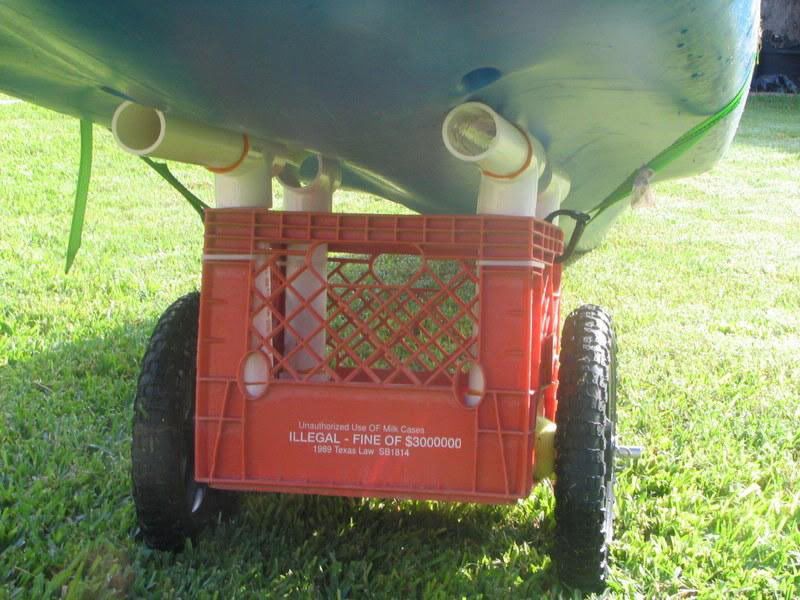 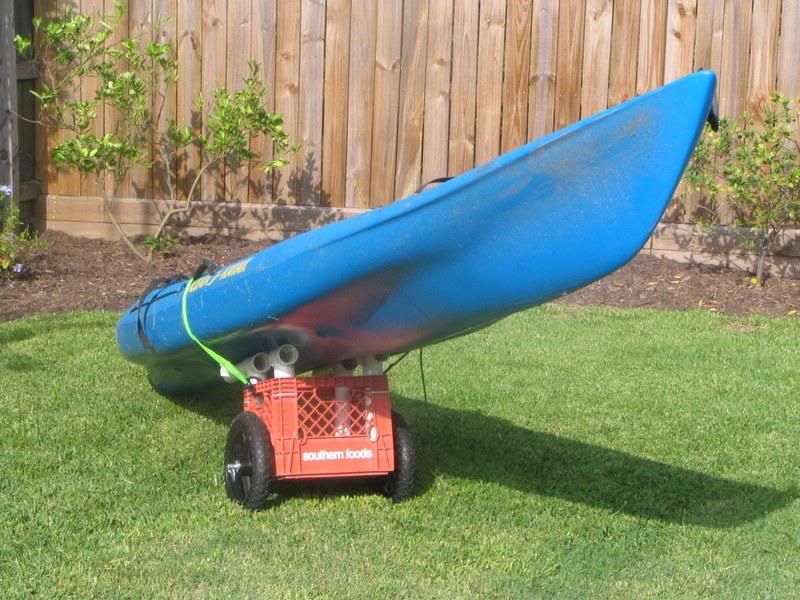 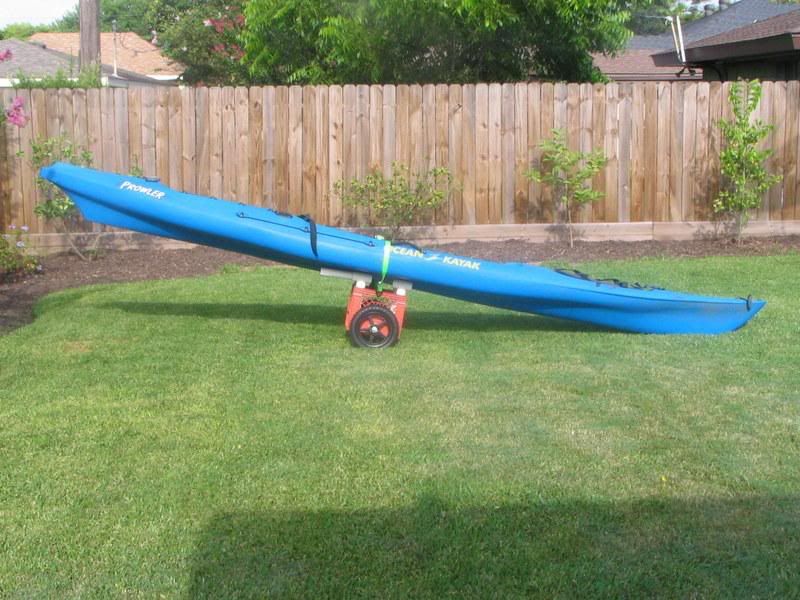
|
|
|

|
|
|
#35 |
|
Senior Member
How Do You Identify?:
Alpha Femme Preferred Pronoun?:
Goddess Relationship Status:
Completely in love Join Date: Nov 2009
Location: Southern Virginia
Posts: 3,225
Thanks: 2,564
Thanked 8,992 Times in 2,247 Posts
Rep Power: 21474856            |
My kayaks are about 12 years old now and the model has changed but they are something like this:
http://www.oceankayak.com/kayaks/sin...aks/caper.html Only mine are longer. I selected the Ocean kayak for its versatility. I first bought them when I had my place in Key largo and enjoyed ocean, bay, fishing and even took them out camping overnight back in the swamps. I love fishing with a kayak because its quiet and I can get into tight places. I can carry quite a bit of gear and they are difficult, not impossible, to tip. Now in southern VA I enjoy lakes and actually did quite a bit of kayaking this past summer. I love being out in the water and not hearing the sound of motors.
__________________
You either like me or you don't. It took me Twenty-something years to learn how to love myself, I don't have that kinda time to convince somebody else.
~ Daniel Franzese |
|
|

|
|
|
#36 |
|
Senior Member
How Do You Identify?:
With my drivers Lic. Preferred Pronoun?:
Gentleman.. Depends on the Situation. Relationship Status:
Last Rodeo, what a ride, many sunrises & sunsets to be had... Join Date: Nov 2009
Location: where a realtor had me sign the dotted line
Posts: 1,901
Thanks: 6,466
Thanked 5,456 Times in 1,450 Posts
Rep Power: 21474854            |
One of the best cleaner/protectants out on the market for your yak is called 303 Aerospace Protectant. You don't have to get the whole kit, you can just get the Protectant.
After a long day in the ocean, it's best to run your vehicle and your yak to a power washer car wash. When you get home, open the hatches and plugs and rinse the inside out and let dry. Usually after 3 or 4 yak trips it's good to use this product. And if you want to keep the scrapes and scratches down you can use surf board wax on the bottom, messy but does help to slide in dirt and sand. 303 Boat Care Kit Total boat care made easy! The 303 Boat Kit is a maintenance kit for all marine surfaces including fiberglass, plastics, carpet, metal, vinyl, and rubber. The 303 Boat Kit includes manufacturer recommended products plus 303 Aerospace Protectant, the only protectant with an SPF of 40. Give your boat the very best preventative care with the 303 Boat Kit! The 303 Boat Kit includes:
|
|
|

|
|
|
#37 | |
|
Senior Member
How Do You Identify?:
Alpha Femme Preferred Pronoun?:
Goddess Relationship Status:
Completely in love Join Date: Nov 2009
Location: Southern Virginia
Posts: 3,225
Thanks: 2,564
Thanked 8,992 Times in 2,247 Posts
Rep Power: 21474856            |
Quote:
have you used this stuff? I might use it on a fiberglass kayak but not on a molded plastic hull which is what many sit on kayaks are. I also use to have a 24 ft Proline and this stuff was awful. Most boat paint today will hold up fine and washed with soap and water. Then maybe once or 3 times a year, for a fiberglass boat only, I'd do a super good wax job with the old fashion stuff. this is my opinion from someone who has used it. This is another reason to consider Ocean kayaks and the like. These kayaks have last 12 plus year so far being in the ocean, sun, dragged across the road, you name it. They may not be a good choice for winter northern kayakers because they are open and you will get wet but great for southern summer kayaking. Thanks for the thread
__________________
You either like me or you don't. It took me Twenty-something years to learn how to love myself, I don't have that kinda time to convince somebody else.
~ Daniel Franzese |
|
|
|

|
|
|
#38 |
|
Senior Member
How Do You Identify?:
Femme Preferred Pronoun?:
She Relationship Status:
N/A Join Date: Mar 2010
Location: NY
Posts: 3,742
Thanks: 7,696
Thanked 7,077 Times in 2,316 Posts
Rep Power: 21474854            |
Love kayaking, and over the years it's where I've gotten some of my favorite photos. I'd be happy to share tips, tricks and products for waterproofing and carrying camera gear.
 
|
|
|

|
|
|
#39 | |
|
Senior Member
How Do You Identify?:
With my drivers Lic. Preferred Pronoun?:
Gentleman.. Depends on the Situation. Relationship Status:
Last Rodeo, what a ride, many sunrises & sunsets to be had... Join Date: Nov 2009
Location: where a realtor had me sign the dotted line
Posts: 1,901
Thanks: 6,466
Thanked 5,456 Times in 1,450 Posts
Rep Power: 21474854            |
Quote:
But I do agree with you on the Ocean kayaks, there great, only thing I didn't like on the 14' and 16' is to many scuppers to worry about plugging, lol. It's why I am interested in the Coosa, it has a hull plate that can be changed out once it wears out from dragging you yak. I really like that concept. I guess everyone does have there own likings. Example, most of my friends use a scupper plug, I use the practice foam golf balls to plug my scuppers. As long as your happy, and you paddle hard then life is good no matter what product you use, Thanks for sharing Sachita. Opinions are good! |
|
|
|

|
| The Following User Says Thank You to Blaze For This Useful Post: |
|
|
#40 |
|
Senior Member
How Do You Identify?:
With my drivers Lic. Preferred Pronoun?:
Gentleman.. Depends on the Situation. Relationship Status:
Last Rodeo, what a ride, many sunrises & sunsets to be had... Join Date: Nov 2009
Location: where a realtor had me sign the dotted line
Posts: 1,901
Thanks: 6,466
Thanked 5,456 Times in 1,450 Posts
Rep Power: 21474854            |
By all means, please do share! I love to learn more and more on tips and tricks, and things that work and don't. Thank you for the lovely pictures and looking forward to hearing from you on this thread.
|
|
|

|
 |
|
|